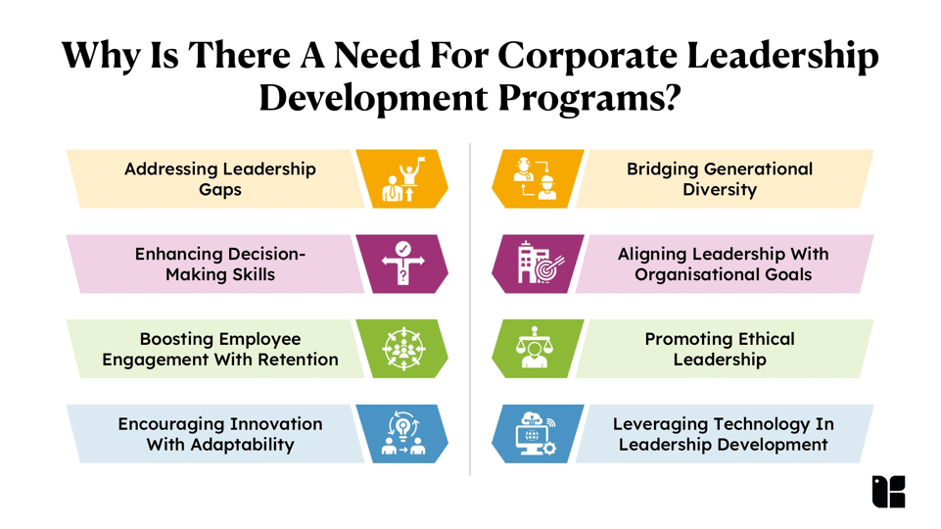Leaders today are more than decision-makers; they inspire, innovate, and overcome challenges. Corporate leadership development programs are essential for bridging the gap between current skills and future needs, ensuring organisations remain competitive. This article explores their role in shaping effective leadership for the future.
What Are Corporate Leadership Development Programs?
Corporate leadership development programs are structured initiatives designed to enhance the skills, knowledge, and abilities of individuals in leadership roles or those with leadership potential. These programs aim to align leadership capabilities with organisational goals, ensuring that leaders are well-equipped to drive business success.
A significant portion of employees view leadership development opportunities as essential for career advancement, with 84% believing that such opportunities are crucial for their professional growth. They typically include a combination of workshops, mentoring, coaching, on-the-job training, and technology-driven learning modules. By focusing on areas such as strategic thinking, emotional intelligence, decision-making, and innovation, these programs prepare leaders to tackle modern business challenges effectively.
Why Is There A Need For Corporate Leadership Development Programs?
As businesses adapt to new technologies and market shifts, strong leadership is crucial. Corporate leadership development programs help organisations stay competitive while fostering growth, adaptability, and long-term success. The need for a corporate leadership program can be seen in the following ways:

Addressing Leadership Gaps
When key leaders retire or leave, the resulting void can create uncertainty and disrupt operations. Leadership development programs ensure organisations have a ready pool of skilled individuals to fill these roles effectively. These programs foster proactive succession planning, minimising risks associated with unprepared transitions. Employees also feel motivated to perform better, knowing they have opportunities for growth. By building internal leadership capacity, organisations reduce reliance on external hires, fostering continuity and stability.
Enhancing Decision-Making Skills
Leaders must make informed decisions quickly and effectively. Leadership development programs emphasise critical thinking and problem-solving skills to meet this need. Through structured training, leaders learn to analyse situations comprehensively and develop strategies under pressure. They also gain confidence in their decision-making abilities, even in uncertain scenarios. With enhanced decision-making skills, leaders contribute to more consistent and reliable organisational outcomes.
Boosting Employee Engagement With Retention
organisations that invest in leadership development signal their commitment to employee growth, increasing loyalty and job satisfaction. Employees are more engaged when they feel their potential is recognised. These programs promote a sense of purpose and belonging among employees, directly reducing turnover. Organisations also benefit from a more motivated workforce that actively contributes to long-term success. Prioritising employee development creates a positive workplace culture that attracts top talent.
Encouraging Innovation With Adaptability
Leadership development programs train leaders to adapt to evolving market demands and foster a culture of innovation. This adaptability ensures organisational resilience during periods of rapid change. Leaders learn to embrace new technologies and approaches, empowering their teams to innovate. organisations with adaptable leadership are better positioned to capitalize on emerging trends. By encouraging creativity, leaders drive both incremental and transformative improvements.
Bridging Generational Diversity
Modern workplaces comprise employees from multiple generations, each bringing unique perspectives. Leadership development programs prepare leaders to address generational differences constructively. Through training, leaders learn to communicate effectively with all age groups, fostering mutual understanding. This inclusive approach enhances collaboration, ensuring everyone’s strengths are utilised. By addressing generational diversity, organisations create harmonious teams that thrive on shared goals.
Aligning Leadership With Organisational Goals
Leadership that aligns with an organisation’s mission and vision ensures strategic consistency. Leadership development programs help leaders internalise and execute organisational objectives effectively. These programs train leaders to prioritise initiatives that directly contribute to the company’s success. Leaders also develop the skills to cascade these objectives to their teams, creating alignment at all levels. This alignment fosters efficiency and ensures that resources are used optimally to achieve strategic goals.
Promoting Ethical Leadership
The demand for ethical leadership has grown as organisations face greater scrutiny. Leadership development programs instill a commitment to integrity and accountability in future leaders.
Ethical training empowers leaders to handle challenges transparently, building trust with employees and stakeholders. It also promotes an organisational culture that prioritises fairness and accountability. Over time, ethical leadership strengthens reputations and safeguards organisations from reputational and operational risks.
Leveraging Technology In Leadership Development
Technology plays a transformative role in modern leadership development programs. With tools like virtual reality simulations, AI-driven learning platforms, and real-time feedback systems, organisations can create immersive and personalised training experiences. These technologies enable leaders to practice decision-making in realistic scenarios, track progress with data-driven insights, and continuously refine their skills. Integrating technology not only enhances the effectiveness of these programs but also ensures scalability and accessibility for leaders across the globe.
Conclusion
Corporate leadership development programs are not just an option; they are a necessity for organisations aiming to excel in a competitive environment. By addressing leadership gaps, enhancing decision-making, fostering innovation, and building resilience, these programs lay the foundation for sustained success. In a world where change is the only constant, developing strong and adaptable leaders is the key to unlocking an organisation’s true potential.
